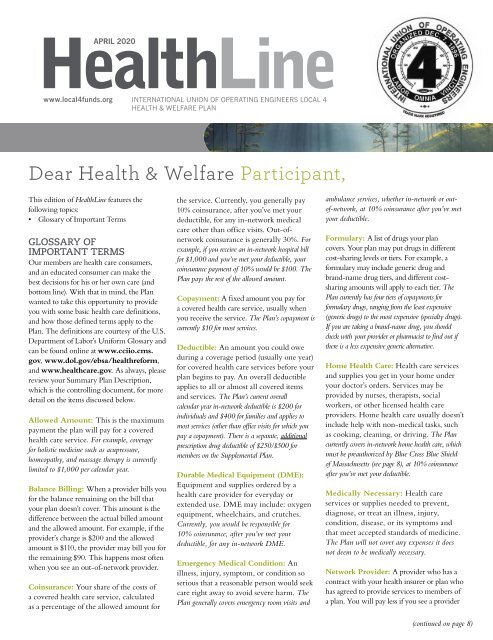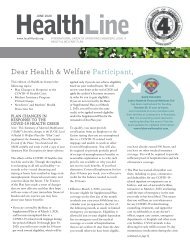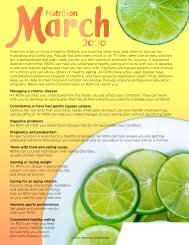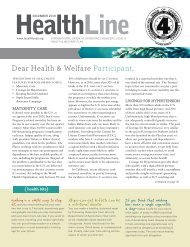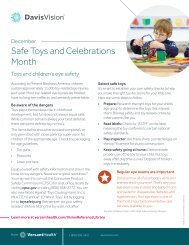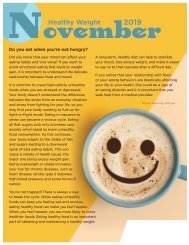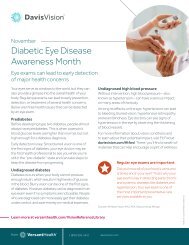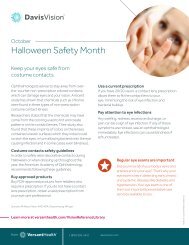April 2020
Create successful ePaper yourself
Turn your PDF publications into a flip-book with our unique Google optimized e-Paper software.
HealthLine<br />
APRIL <strong>2020</strong><br />
www.local4funds.org<br />
INTERNATIONAL UNION OF OPERATING ENGINEERS LOCAL 4<br />
HEALTH & WELFARE PLAN<br />
Dear Health & Welfare Participant,<br />
This edition of HealthLine features the<br />
following topics:<br />
• Glossary of Important Terms<br />
GLOSSARY OF<br />
IMPORTANT TERMS<br />
Our members are health care consumers,<br />
and an educated consumer can make the<br />
best decisions for his or her own care (and<br />
bottom line). With that in mind, the Plan<br />
wanted to take this opportunity to provide<br />
you with some basic health care definitions,<br />
and how those defined terms apply to the<br />
Plan. The definitions are courtesy of the U.S.<br />
Department of Labor’s Uniform Glossary and<br />
can be found online at www.cciio.cms.<br />
gov, www.dol.gov/ebsa/healthreform,<br />
and www.healthcare.gov. As always, please<br />
review your Summary Plan Description,<br />
which is the controlling document, for more<br />
detail on the items discussed below.<br />
Allowed Amount: This is the maximum<br />
payment the plan will pay for a covered<br />
health care service. For example, coverage<br />
for holistic medicine such as acupressure,<br />
homeopathy, and massage therapy is currently<br />
limited to $1,000 per calendar year.<br />
Balance Billing: When a provider bills you<br />
for the balance remaining on the bill that<br />
your plan doesn’t cover. This amount is the<br />
difference between the actual billed amount<br />
and the allowed amount. For example, if the<br />
provider’s charge is $200 and the allowed<br />
amount is $110, the provider may bill you for<br />
the remaining $90. This happens most often<br />
when you see an out-of-network provider.<br />
Coinsurance: Your share of the costs of<br />
a covered health care service, calculated<br />
as a percentage of the allowed amount for<br />
the service. Currently, you generally pay<br />
10% coinsurance, after you’ve met your<br />
deductible, for any in-network medical<br />
care other than office visits. Out-ofnetwork<br />
coinsurance is generally 30%. For<br />
example, if you receive an in-network hospital bill<br />
for $1,000 and you’ve met your deductible, your<br />
coinsurance payment of 10% would be $100. The<br />
Plan pays the rest of the allowed amount.<br />
Copayment: A fixed amount you pay for<br />
a covered health care service, usually when<br />
you receive the service. The Plan’s copayment is<br />
currently $10 for most services.<br />
Deductible: An amount you could owe<br />
during a coverage period (usually one year)<br />
for covered health care services before your<br />
plan begins to pay. An overall deductible<br />
applies to all or almost all covered items<br />
and services. The Plan’s current overall<br />
calendar year in-network deductible is $200 for<br />
individuals and $400 for families and applies to<br />
most services (other than office visits for which you<br />
pay a copayment). There is a separate, additional<br />
prescription drug deductible of $250/$500 for<br />
members on the Supplemental Plan.<br />
Durable Medical Equipment (DME):<br />
Equipment and supplies ordered by a<br />
health care provider for everyday or<br />
extended use. DME may include: oxygen<br />
equipment, wheelchairs, and crutches.<br />
Currently, you would be responsible for<br />
10% coinsurance, after you’ve met your<br />
deductible, for any in-network DME.<br />
Emergency Medical Condition: An<br />
illness, injury, symptom, or condition so<br />
serious that a reasonable person would seek<br />
care right away to avoid severe harm. The<br />
Plan generally covers emergency room visits and<br />
ambulance services, whether in-network or outof-network,<br />
at 10% coinsurance after you’ve met<br />
your deductible.<br />
Formulary: A list of drugs your plan<br />
covers. Your plan may put drugs in different<br />
cost-sharing levels or tiers. For example, a<br />
formulary may include generic drug and<br />
brand-name drug tiers, and different costsharing<br />
amounts will apply to each tier. The<br />
Plan currently has four tiers of copayments for<br />
formulary drugs, ranging from the least expensive<br />
(generic drugs) to the most expensive (specialty drugs).<br />
If you are taking a brand-name drug, you should<br />
check with your provider or pharmacist to find out if<br />
there is a less expensive generic alternative.<br />
Home Health Care: Health care services<br />
and supplies you get in your home under<br />
your doctor’s orders. Services may be<br />
provided by nurses, therapists, social<br />
workers, or other licensed health care<br />
providers. Home health care usually doesn’t<br />
include help with non-medical tasks, such<br />
as cooking, cleaning, or driving. The Plan<br />
currently covers in-network home health care, which<br />
must be preauthorized by Blue Cross Blue Shield<br />
of Massachusetts (see page 8), at 10% coinsurance<br />
after you’ve met your deductible.<br />
Medically Necessary: Health care<br />
services or supplies needed to prevent,<br />
diagnose, or treat an illness, injury,<br />
condition, disease, or its symptoms and<br />
that meet accepted standards of medicine.<br />
The Plan will not cover any expenses it does<br />
not deem to be medically necessary.<br />
Network Provider: A provider who has a<br />
contract with your health insurer or plan who<br />
has agreed to provide services to members of<br />
a plan. You will pay less if you see a provider<br />
(continued on page 8)
2<br />
(recipe)<br />
Zucchini Potato<br />
Pancakes<br />
THE BIG BENEFITS OF<br />
Eating Less Meat<br />
1 medium zucchini, grated (about 1¼ cups)<br />
1 medium Yukon gold potato, grated<br />
(about 2 cups)<br />
½ cup rolled oats<br />
½ cup whole-grain bread crumbs<br />
1 egg<br />
2 tbsp. dried, minced onions<br />
1 tsp. onion powder<br />
1 tsp. garlic powder<br />
½ tsp. freshly ground black pepper<br />
½ tsp. salt<br />
Olive oil spray<br />
A VEGETARIAN LIFESTYLE CAN BE<br />
GOOD FOR BOTH YOUR HEALTH<br />
AND THE ENVIRONMENT. But what<br />
if you appreciate a chicken enchilada<br />
once in a while?<br />
A flexitarian, or “flexible<br />
vegetarian,” diet could be your<br />
solution. Flexitarians mainly eat<br />
plant-based foods, such as vegetables,<br />
fruits, whole grains, beans, nuts, and<br />
tofu, as well as eggs and low-fat or<br />
nonfat dairy products. But unlike<br />
vegetarians, they also eat meat,<br />
poultry, or fish occasionally—<br />
once a week or less.<br />
The flexitarian diet has many health<br />
benefits. It helps you decrease the<br />
amount of saturated fat and cholesterol<br />
you eat. It also helps you eat more<br />
vegetables, fruits, and grains. Plus,<br />
research suggests that a flexitarian<br />
diet helps with weight control and<br />
lowers your risk for heart disease<br />
and diabetes.<br />
Going flexitarian can have a<br />
positive influence on the environment,<br />
too. Lower beef consumption,<br />
especially, could decrease greenhouse<br />
gas emissions from food production<br />
by up to 35 percent.<br />
If you decide to go flexitarian,<br />
you should still avoid less nutritious<br />
choices whenever possible, such as<br />
desserts, sugary drinks, salty snacks,<br />
and refined grains like white bread.<br />
Strive to eat protein-rich foods, such<br />
as legumes and nuts. When you eat<br />
meat, ensure it’s lean.<br />
Remember, this diet isn’t about<br />
excluding entire food categories. It’s<br />
about savoring a variety of delicious,<br />
nutritious foods—including the<br />
occasional salmon filet or juicy<br />
lean burger.<br />
In a food processor fitted with a standard<br />
blade, add zucchini, potato, and oats. Process<br />
for about 20 to 30 seconds—just enough to<br />
combine and chop up more finely. In a large<br />
bowl, stir together potato-zucchini-oat<br />
mixture with remaining ingredients. Form<br />
into six pancakes. Heat a griddle on high for<br />
two minutes. Spray with olive oil, then add<br />
pancakes. Cook for about five minutes per<br />
side or until just browned. Try topping with<br />
applesauce or real maple syrup.<br />
Serves six; serving size is one pancake.<br />
Each serving provides about 148 calories,<br />
2 g total fat (0.4 g saturated fat, 0 g trans fat),<br />
35 mg cholesterol, 170 mg sodium,<br />
27 g carbohydrates, 4 g fiber, 2 g sugar,<br />
and 6 g protein.
DOES SOCIAL MEDIA<br />
MOTIVATE OR DISCOURAGE YOU<br />
TO WORK OUT?<br />
3<br />
IT’S A QUESTION WE OFTEN WONDER<br />
ABOUT—DOES SCROLLING THROUGH<br />
SOCIAL MEDIA have a positive or<br />
negative effect on our well-being?<br />
When it comes to fitness-related posts,<br />
there isn’t a clear answer.<br />
In a new study, researchers found that<br />
for some people, seeing exercise-related<br />
social media posts, such as images of<br />
friends exercising or wearing workout<br />
clothes, checking into gyms, or posting<br />
about fitness-related accomplishments,<br />
made them feel motivated to work out.<br />
For others, however, viewing fitness<br />
posts had a negative effect on their body<br />
image. Such posts actually made them<br />
feel badly about their weight.<br />
But that doesn’t mean you have to<br />
shun all social media for fear of negative<br />
effects. Here’s how to handle the feelings<br />
you may experience when scrolling<br />
through fitness posts on your feed.<br />
IF YOU FEEL MOTIVATED<br />
If seeing your friends work out inspires<br />
you to do the same, act on those feelings.<br />
Don’t wait for the perfect time or until<br />
you find the best plan—get started today.<br />
If you’re not sure where to start, find<br />
an exercise buddy. Reach out to your<br />
friends posting about their exercise<br />
routines or fitness achievements. After<br />
all, research shows that working out with<br />
a friend who’s more advanced than you<br />
can help you push harder and longer.<br />
IF YOU FEEL DISCOURAGED<br />
If you find yourself feeling down about<br />
your body after surfing social media sites,<br />
you don’t have to unfollow your friends.<br />
Instead, try practicing self-compassion—<br />
research shows that it can act as a buffer<br />
against comparing your body with others’<br />
or harshly judging your own figure.<br />
The next time social media posts<br />
get you down, follow these<br />
self-compassion tips:<br />
• Remember that no one is perfect.<br />
Everyone makes mistakes and<br />
everyone experiences failure.<br />
• Be kind to yourself. Instead of<br />
judging, understand and accept<br />
where you are in your fitness journey.<br />
• Recognize that all bodies are<br />
different—and almost all fall<br />
short of our ideals.<br />
Above all, remember that exercise is<br />
about much more than losing weight.<br />
Increasing your physical activity can<br />
reduce your risk for disease, improve<br />
your sleep, and help you feel better<br />
in your own skin.
4<br />
Could Your Child Have a<br />
Learning Disability?<br />
IT’S NORMAL FOR KIDS TO FIND SOME<br />
SCHOOL SUBJECTS HARDER THAN<br />
OTHERS. And it’s common for them to<br />
struggle a bit when learning something<br />
new. But if learning troubles become a<br />
lasting pattern, you might start to suspect<br />
a learning disability.<br />
Reading, writing, and doing math<br />
are the basic building blocks of school<br />
success. Learning disabilities affect how<br />
your child performs these essential<br />
skills. Learning issues aren’t tied<br />
to intelligence—even bright kids can<br />
have learning disabilities. Instead,<br />
they’re caused by problems with how<br />
the brain handles information.<br />
WHAT TO WATCH FOR<br />
There are various types of learning<br />
disabilities. Here are typical signs of<br />
three common ones.<br />
DYSLEXIA<br />
Difficulties with reading and spelling<br />
• Trouble recognizing and spelling<br />
words that are known<br />
• Difficulty reading with accuracy<br />
and ease<br />
• Often finding it hard to understand<br />
what other people say<br />
DYSCALCULIA<br />
Difficulties with arithmetic<br />
• Trouble grasping arithmetic concepts,<br />
such as fractions and negative numbers<br />
• Difficulty understanding math<br />
word problems<br />
• Mistakes when making change for cash<br />
• Often struggling with the time<br />
sequence of events<br />
DYSGRAPHIA<br />
Difficulties with handwriting<br />
• Tension and an awkward position<br />
when writing by hand<br />
• Trouble forming letters or writing<br />
within a designated space<br />
• Often having a hard time getting<br />
ideas down on paper<br />
Not every child with these signs has a<br />
learning disability. Developmental delays,<br />
vision or hearing problems, emotional<br />
disorders, and medical illnesses can also<br />
affect learning. Your child’s doctor and<br />
school can help you determine what’s<br />
going on.<br />
CONSULT YOUR PEDIATRICIAN<br />
Talk with your child’s pediatrician about<br />
your concerns. The pediatrician can look<br />
for health problems that might be playing<br />
a role. For example, let’s say your child has<br />
a chronic health condition, such as asthma<br />
or type 1 diabetes. If the condition isn’t<br />
well-controlled, that could lead to<br />
frequent absences and falling grades.<br />
At times, the pediatrician may refer<br />
your child to other specialists for further<br />
evaluation. For instance, your child<br />
might see a neurologist, psychologist,<br />
or speech pathologist.<br />
CONTACT YOUR CHILD’S SCHOOL<br />
Share what you discover with your<br />
child’s school. If you think your child<br />
may have a learning disability, ask for<br />
an educational assessment. This type of<br />
assessment can determine whether your<br />
child qualifies for special education<br />
services. Such services help your child<br />
learn to build on strengths and<br />
compensate for weaknesses.<br />
A learning disability is a lifelong<br />
challenge. It can’t be cured, but its<br />
impact can be lessened. With support<br />
from family, health care providers,<br />
and teachers, your child with a<br />
learning disability can thrive<br />
at school and beyond.
5<br />
HPV VACCINE<br />
AND<br />
:<br />
KNOW THE FACTS<br />
THE HUMAN PAPILLOMAVIRUS (HPV)<br />
VACCINE IS KNOWN FOR PREVENTING<br />
CERVICAL CANCER—and for good<br />
reason. Health care providers began<br />
recommending the shot for females more<br />
than 10 years ago. Since then, the rate of<br />
cervical precancers linked to common<br />
HPV types has dropped 40 percent.<br />
But HPV eventually infects nearly<br />
every sexually active person, male or<br />
female. Boys and men also face<br />
consequences. The virus can cause<br />
cancers of the mouth, back of the<br />
throat, penis, and anus, along with<br />
genital warts.<br />
That’s why vaccination matters for<br />
boys as well as girls. In 2011, providers<br />
began suggesting the shots for all young<br />
people. Ideally, all children should get<br />
two doses, six to 12 months apart,<br />
beginning at age 11 or 12.<br />
THE COST OF SKIPPING SHOTS<br />
Despite this guidance, only 28 percent<br />
of boys in the recommended age group<br />
have received the HPV vaccine. That’s<br />
compared with almost 42 percent of girls.<br />
This low rate is worrying. In a recent<br />
study, about 45 percent of adult men had<br />
a genital HPV infection. One-fourth had<br />
a high-risk strain of the virus.<br />
Parents of boys may not realize:<br />
• The most common cancer caused<br />
by HPV is mouth and throat cancer,<br />
which affects more males than females<br />
• Nearly four out of 10 HPV-related<br />
cancers strike men<br />
• Each year, more than 14,000 American<br />
men develop HPV-related cancers<br />
Males who get vaccinated will also protect<br />
their future partners, including women<br />
who are at risk for cervical cancer.<br />
LOW RISK, LONG-TERM REWARD<br />
The shots work best when preteens and<br />
teens receive them before becoming<br />
sexually active, when they haven’t yet been<br />
exposed to the virus. And preadolescents<br />
produce more antibodies than older teens.<br />
That’s why health care providers<br />
recommend starting young—as early as<br />
age 9. But even if your son is older, it’s not<br />
too late. The government recommends<br />
young adults who aren’t already vaccinated<br />
receive HPV shots through age 26.<br />
If you have questions about the<br />
HPV vaccine, talk with your child’s<br />
pediatrician. Overall, the shots are very<br />
safe. Minor side effects include pain,<br />
dizziness, nausea, or headaches.<br />
Because of how it’s made, the vaccine<br />
can’t transmit the virus. And it provides<br />
protection against HPV for years to come<br />
—there’s no evidence the protection<br />
decreases over time.
Lorem ipsum<br />
Lorem ipsum<br />
Lorem ipsum<br />
Lorem ipsum<br />
6<br />
7 Ways to<br />
Weed Plastıcs<br />
Out of Your Life<br />
Swap this for that to protect your health, your family, and the environment.<br />
SKIP THIS<br />
CHOOSE THAT<br />
Plastic cups<br />
for hot drinks<br />
Porcelain, glass, or<br />
stainless steel mugs<br />
Disposable plastic<br />
eating utensils<br />
Reusable stainless<br />
steel utensils<br />
Plastic food containers<br />
(especially for holding and<br />
heating hot foods)<br />
Porcelain, glass, or stainless steel<br />
food containers<br />
Lorem ipsum<br />
Plastic water bottles<br />
Stainless steel water bottles<br />
Lorem ipsum<br />
Plastic<br />
baby bottles<br />
(especially older<br />
hand-me-downs)<br />
Lorem ipsum<br />
Lorem ipsum<br />
Glass baby bottles<br />
(slip them inside a<br />
silicone sleeve to<br />
prevent breaking)<br />
Lorem ipsum<br />
Lorem ipsum<br />
Disposable plastic<br />
shopping bags<br />
Reusable cloth bags (wash<br />
them frequently)<br />
Plastic straws<br />
No straw<br />
FOR YOUR HEALTH<br />
Bisphenol A (BPA) and phthalates, chemicals found in<br />
some plastics, have been linked to potential health risks.<br />
More than 90 percent of Americans ages 6 and older<br />
have detectable levels of BPA in their bodies.<br />
FOR YOUR WORLD<br />
More than 26 million tons of U.S.-made plastics<br />
<br />
end up in landfills every year.<br />
Up to 90 percent of the trash littering our o ceans<br />
and coastlines is plastic.
GROW AN<br />
Allergy-Friendly GARDEN<br />
THEY SAY YOU REAP WHAT YOU<br />
SOW—AND WHEN IT COMES TO<br />
GARDENING WITH ALLERGIES, that old<br />
saying couldn’t be more true. If you’re<br />
one of the 40 to 60 million Americans<br />
with hay fever, your symptoms can be<br />
aggravated by pollen from grasses, trees,<br />
and weeds in your neighborhood. But<br />
planting certain seeds, shrubs, and<br />
saplings this spring can help you have<br />
fewer symptoms all season long.<br />
UPROOT THESE GRASSES AND TREES<br />
Seasonal allergies occur when your body<br />
treats pollen in the air as an unwelcome<br />
invader. This overreaction can cause<br />
congestion, sneezing, a runny nose, a<br />
scratchy throat, and itchy, watery eyes.<br />
Some greenery can make allergy<br />
symptoms worse than others. Aim<br />
to keep these irritating offenders off<br />
your property:<br />
• Grasses: johnsongrass, rye,<br />
timothy, Bermuda, orchard,<br />
sweet vernal, bluegrass, fescue<br />
• Allergy-triggering trees: maple,<br />
oak, ash, birch, hickory, juniper,<br />
cedar, cottonwood<br />
RAISE THESE FRUITS AND<br />
FLOWERS INSTEAD<br />
Having allergies doesn’t mean<br />
you’re stuck landscaping with gravel<br />
and concrete. These buds and blooms<br />
will beautify your yard with less chance<br />
of giving you the sniffles:<br />
• Flowers: lilac, daisy, geranium,<br />
dahlia, hibiscus, iris, roses,<br />
snapdragon, tulips<br />
• Low-allergen trees: cherry, crepe<br />
myrtle, redwood, apple, dogwood,<br />
pear, plum<br />
Another option? If you’re in a<br />
warm, dry climate, consider succulents,<br />
such as cactus plants.<br />
HEDGE YOUR BETS WITH<br />
THESE HABITS<br />
Gardening is good exercise,<br />
produces nutritious fruits and<br />
vegetables, and helps beautify<br />
your community. In short, it’s<br />
worth the effort, even with<br />
allergies. To increase your<br />
comfort, follow these tips:<br />
• Take your allergy medications<br />
before you head outside. And if<br />
you have asthma, keep your<br />
quick-relief drugs on hand.<br />
• No matter what type of grass<br />
you have, keep it short. If you<br />
can, ask someone else to mow.<br />
• Don’t touch your eyes or face while<br />
you’re working. Try wearing a mask<br />
and gloves.<br />
This Spring<br />
• Wash your hands often and rinse<br />
your eyes when you come back<br />
inside. Shower right away to help<br />
ease your symptoms.<br />
• Visit an allergist. He or she can help<br />
you identify the plants that aggravate<br />
your symptoms. You might benefit<br />
from treatments such as allergy shots.<br />
Now get growing!<br />
77<br />
CHECK POLLEN<br />
COUNTS IN YOUR AREA<br />
Visit www.aaaai.org/global/<br />
nab-pollen-counts. Skip<br />
gardening on days when<br />
pollen counts are high.
IUOE Local 4 Health & Welfare Plan<br />
PO Box 660<br />
Medway, MA 02053-0660<br />
PRSRT STD<br />
U.S. POSTAGE<br />
PAID<br />
LONG PRAIRIE, MN<br />
PERMIT NO. 372<br />
www.local4funds.org<br />
6272M<br />
(continued from page 1)<br />
in the network. Also called “preferred<br />
provider” or “participating provider.” If you<br />
see an out-of-network provider, you will currently<br />
be responsible for 30% coinsurance after you’ve<br />
met your deductible. This higher coinsurance<br />
applies to almost all out-of-network service,<br />
including office visits.<br />
Out-of-Pocket Limit: The most you<br />
could pay during a coverage period<br />
(usually one year) for your share of the<br />
costs of covered services. After you<br />
meet this limit, the plan will usually<br />
pay 100% of the allowed amount. This<br />
limit helps you plan for health care costs.<br />
This limit never includes your premium,<br />
balance-billed charges, or health care<br />
your plan doesn’t cover. Some plans don’t<br />
count all of your copayments, deductibles,<br />
coinsurance payments, out-of-network<br />
payments, or other expenses toward<br />
this limit. The Plan’s current out-of-pocket<br />
limit is $7,350 (individual) and $14,700<br />
(family) for your medical and prescription drug<br />
expenses combined. The limit does not include<br />
prescription copayments or services with separate<br />
benefit maximums (such as holistic benefits).<br />
Preauthorization: A decision by your<br />
health insurer or plan that a health care<br />
service, treatment plan, prescription drug,<br />
or durable medical equipment (DME) is<br />
medically necessary. Sometimes called<br />
“prior authorization,” “prior approval,” or<br />
“precertification.” Your health insurance<br />
or plan may require preauthorization for<br />
certain services before you receive them,<br />
except in an emergency. Preauthorization<br />
isn’t a promise your health insurance or<br />
plan will cover the cost. The Plan requires<br />
preauthorization for all non-emergency and<br />
non-maternity inpatient admissions, partial<br />
hospitalizations/intensive outpatient substance<br />
use treatment programs, home infusion therapy,<br />
and home health care. Blue Cross Blue Shield of<br />
Massachusetts provides preauthorization review for<br />
medical care; Modern Assistance Programs (MAP)<br />
provides preauthorization review for psych/substance<br />
abuse services. There are also prescription drugs<br />
that require prior authorization review, which is<br />
performed by CVS.<br />
Premium: The amount that must be paid<br />
for your health insurance or plan. You do not<br />
pay any premiums for your health care. The Plan<br />
is funded by your employer’s collectively bargained<br />
fringe benefit contributions.<br />
Preventive Care: Routine health care,<br />
including screenings, checkups, and<br />
patient counseling, to prevent or discover<br />
illness, disease, or other health problems.<br />
The Plan has a $0 copayment for preventive<br />
care, including routine physicals, gynecological<br />
exams, mammograms, colonoscopies, and certain<br />
screenings. Preventive prescription drugs are also<br />
covered at a $0 copayment, including contraceptives<br />
and certain statins and smoking cessation drugs.<br />
Provider: An individual or facility<br />
that provides health care services. Some<br />
examples of a provider include a doctor,<br />
nurse, chiropractor, physician assistant,<br />
hospital, surgical center, skilled nursing<br />
facility, and rehabilitation center. The<br />
plan may require the provider to be<br />
licensed, certified, or accredited as<br />
required by state law.<br />
Rehabilitation Services: Health care<br />
services that help a person keep, get back,<br />
or improve skills and functioning for daily<br />
living that have been lost or impaired<br />
because a person was sick, hurt, or<br />
disabled. The Plan currently covers in-network<br />
cardiac rehabilitation at 10% coinsurance after<br />
you pay your deductible, and in-network physical<br />
therapy and occupational therapy at a $10<br />
copayment. Short-term rehabilitation for PT and<br />
OT is limited to 100 visits per calendar year.<br />
Specialty Drug: A type of prescription<br />
drug that, in general, requires special<br />
handling or ongoing monitoring and<br />
assessment by a health care professional, or<br />
is relatively difficult to dispense. Generally,<br />
specialty drugs are the most expensive<br />
drugs on a formulary. The current copayment<br />
for specialty drugs is $200 for a 30-day supply.<br />
Urgent Care: Care for an illness, injury,<br />
or condition serious enough that a<br />
reasonable person would seek care right<br />
away, but not so severe as to require<br />
emergency room care. The Plan covers office<br />
visits at a freestanding urgent care facility, or a<br />
CVS MinuteClinic, at a $0 copayment.<br />
Sincerely,<br />
Your Board of Trustees<br />
William D. McLaughlin, Chairman<br />
Angelo Colasante<br />
Paul C. DiMinico<br />
David F. Fantini<br />
David B. Marr, Jr.<br />
James Reger<br />
IUOE Local 4<br />
William D. McLaughlin, Business<br />
Manager<br />
Administrator<br />
Gina M. Alongi<br />
Information in the publication is the opinion of the authors. Personal decisions regarding health, finance, exercise, and other matters should be made after consultation with the reader’s professional advisors. All<br />
models used for illustrative purposes only. All editorial rights reserved. Developed by StayWell.


